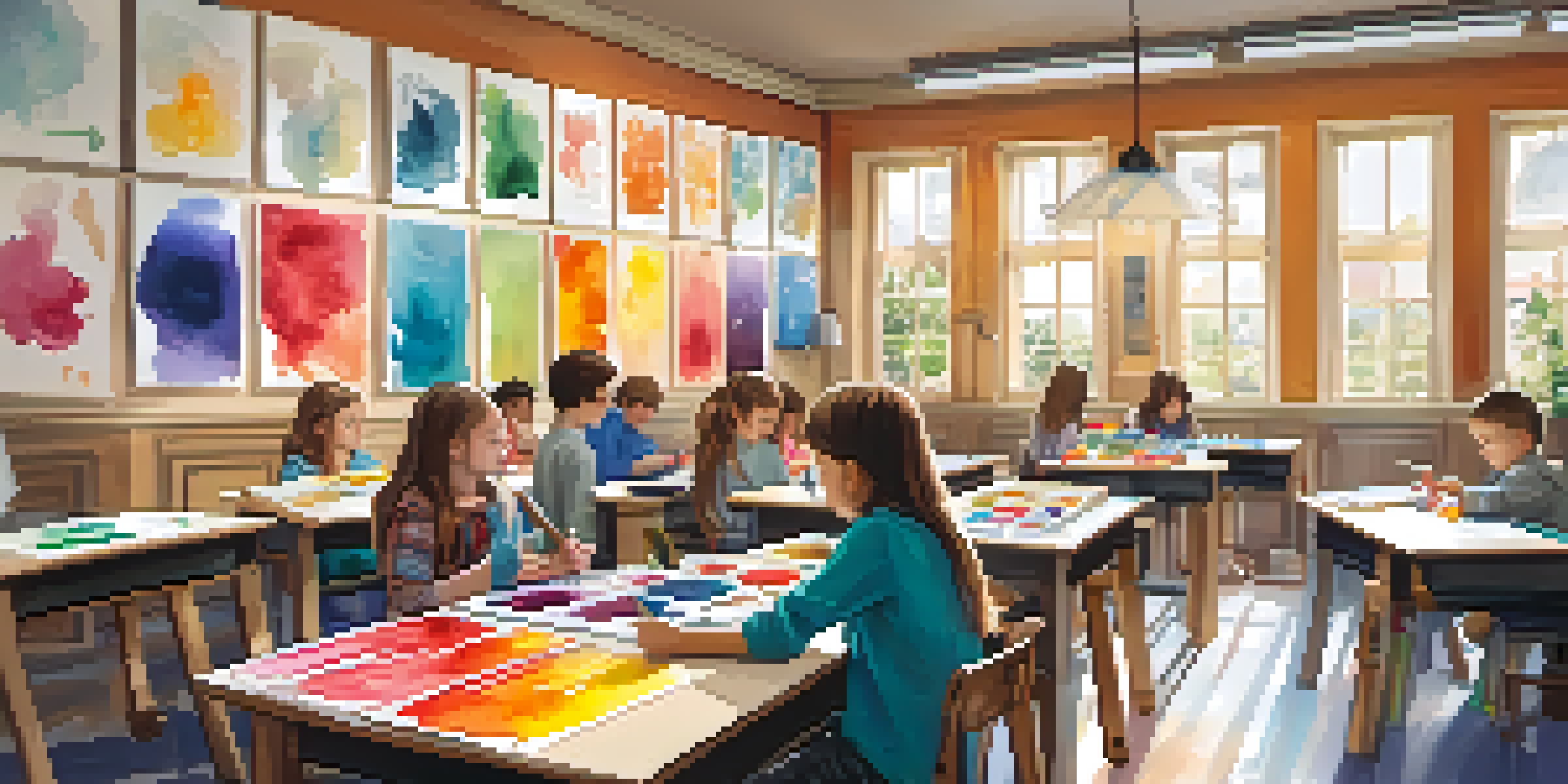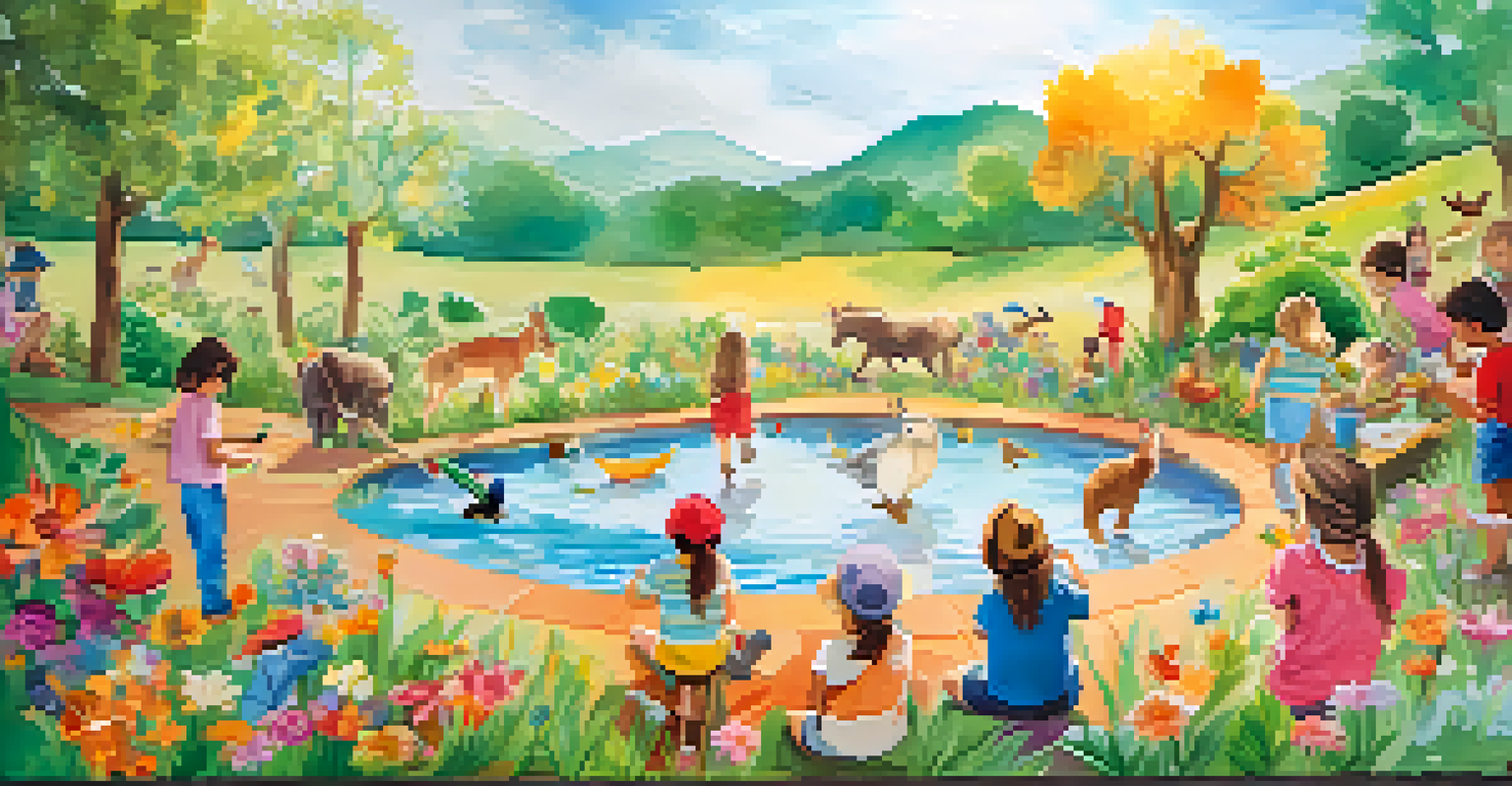Techniques for Teaching Watercolor to Young Art Students

Creating a Fun, Inviting Learning Environment
Setting the stage for creativity is crucial when teaching watercolor to young students. A bright, organized workspace encourages exploration and reduces distractions. Incorporating art supplies that are colorful and easily accessible can make the learning space feel inviting and inspiring.
Every artist was first an amateur.
Consider decorating the area with examples of watercolor art to spark excitement. This not only showcases the possibilities but serves as a visual guide for students. A well-arranged environment fosters a sense of belonging, making kids feel comfortable to express themselves.
Don’t forget the importance of comfort! Ensure that seating arrangements and materials are appropriate for their age and size. A cozy and welcoming atmosphere can help motivate young artists to dive into their watercolor projects with enthusiasm.
Introducing Basic Techniques Through Play
When it comes to teaching watercolor, turning lessons into playful activities can significantly enhance engagement. Simple techniques like wet-on-wet or wet-on-dry can be introduced through games. For example, have students create a 'splash board' where they can freely experiment with colors and techniques without pressure.

This hands-on approach allows children to learn by doing, which is often more effective than traditional instruction. Encourage them to explore mixing colors and observing how they react on paper. Playful experimentation helps demystify the medium, making it less intimidating.
Create an Inviting Learning Space
A bright and organized workspace, filled with colorful supplies, encourages young artists to explore and express their creativity.
Using playful prompts, such as painting their favorite animal or a whimsical landscape, can also boost their creativity. The focus shifts from 'getting it right' to enjoying the process of painting, fostering a love for art that can last a lifetime.
Incorporating Nature for Inspiration
Nature is a fantastic source of inspiration for young artists, and incorporating outdoor activities can enhance their watercolor skills. Organize field trips to parks or gardens where students can observe colors and forms in real life. Observing nature firsthand allows them to draw from their surroundings in a meaningful way.
Art is not freedom from discipline, but disciplined freedom.
Encourage students to bring back sketches or photographs to use as references for their paintings. This not only helps them practice their observation skills but also connects them to the natural world. Art becomes a medium through which they can express their emotions and experiences.
Additionally, discussing the colors found in nature can spark conversations about color theory and blending. Students can learn how to mix greens from various plants or capture the vibrant hues of a sunset, making their artwork more reflective of the world around them.
Encouraging Experimentation with Color Mixing
Color mixing is an essential skill in watercolor painting, and encouraging students to experiment with this can be a fun process. Begin with primary colors and guide them in creating secondary colors through mixing. This hands-on experiment helps them understand color relationships and enhances their artistic vocabulary.
To make this engaging, create a color wheel chart together. Kids can paint sections with their mixed colors, turning it into a vibrant display of their creativity. This visual representation serves as both a learning tool and a source of pride.
Encourage Playful Experimentation
Introducing watercolor techniques through playful activities helps children engage and fosters a love for the art process.
Encourage them to try unexpected combinations as well. By allowing students to step outside of their comfort zone, they can discover unique shades and deepen their understanding of color dynamics in a playful, stress-free environment.
Utilizing Guided Projects for Skill Building
Structured projects can help young artists develop their watercolor skills while still allowing for creativity. Start with simple, guided projects, such as painting a sunset or a flower. This gives students a clear direction while providing the flexibility to express their individual styles.
Break down the project into manageable steps, demonstrating each stage as you go along. For example, show them how to create a gradient for the sunset before moving on to the silhouette of trees. This step-by-step approach can help reduce frustration and build confidence.
Moreover, celebrating their finished projects with a mini-exhibition can motivate students and encourage them to share their work. When children see their creations displayed and appreciated, it reinforces their passion for art and encourages them to continue exploring.
Fostering a Supportive Peer Environment
Creating a supportive community among young artists can greatly enhance their learning experience. Encourage students to share their work and give positive feedback to one another. This not only builds camaraderie but also helps them develop critical thinking skills as they discuss techniques and ideas.
Group projects can also be an excellent way to foster collaboration. For instance, students can work together on a large mural or collective artwork, allowing them to learn from each other while sharing the joy of creation. Such collaborative experiences can deepen their appreciation for different perspectives.
Celebrate Progress and Individuality
Recognizing students' growth and unique styles boosts their confidence and encourages a positive relationship with their artistic journey.
By nurturing a positive environment where students feel safe to express themselves, they are more likely to take creative risks. This supportive atmosphere encourages personal growth and can lead to lasting friendships centered around a love for art.
Celebrating Progress and Individuality
Recognizing and celebrating progress is vital in any art class, and it’s especially important for young learners. Regularly showcasing their artwork can boost confidence and motivate them to keep practicing. Consider having 'artist of the week' features or themed showcases to highlight their efforts.
Emphasizing individuality in art is also crucial. Encourage students to explore their unique styles and preferences, reminding them that there’s no right or wrong way to express themselves. This validation can empower them to embrace their creativity without fear of judgment.

By celebrating both progress and individuality, students can develop a healthy relationship with their artistic journey. It’s about enjoying the process, learning from experiences, and cherishing the personal growth that comes with creating art.